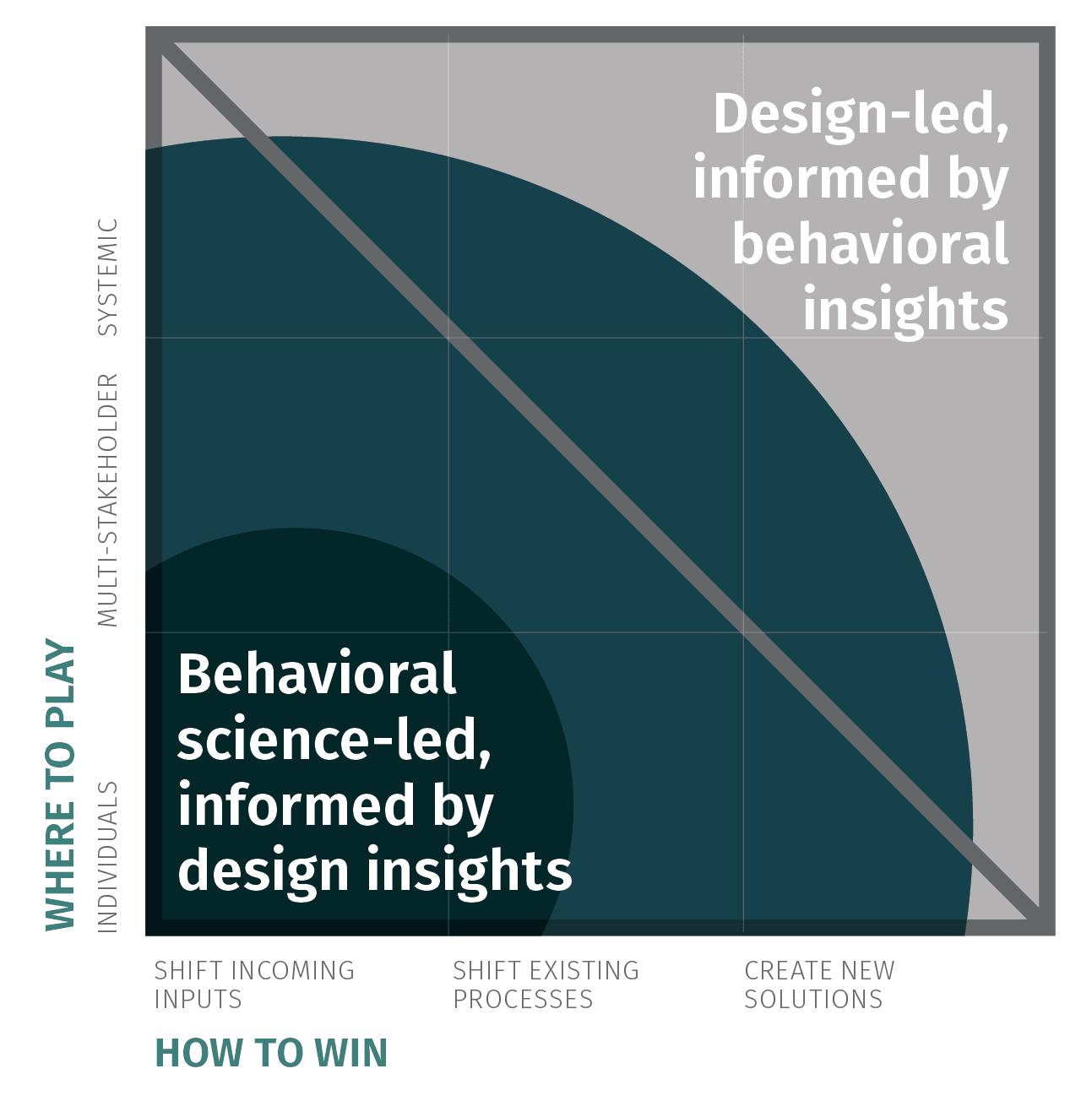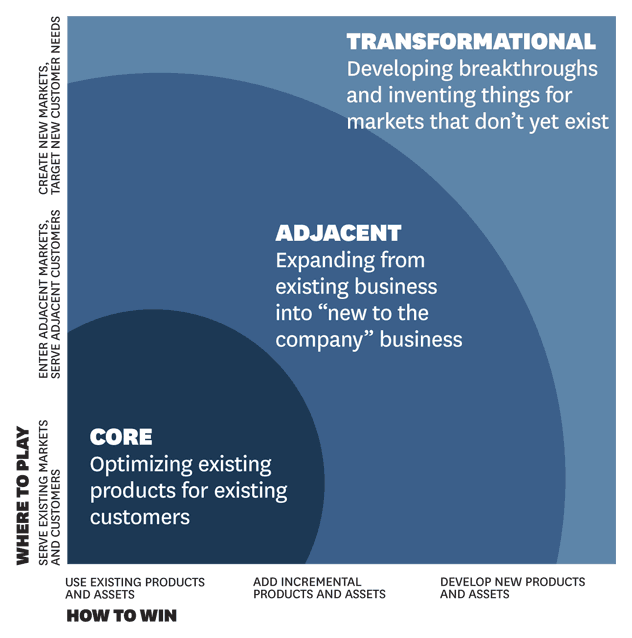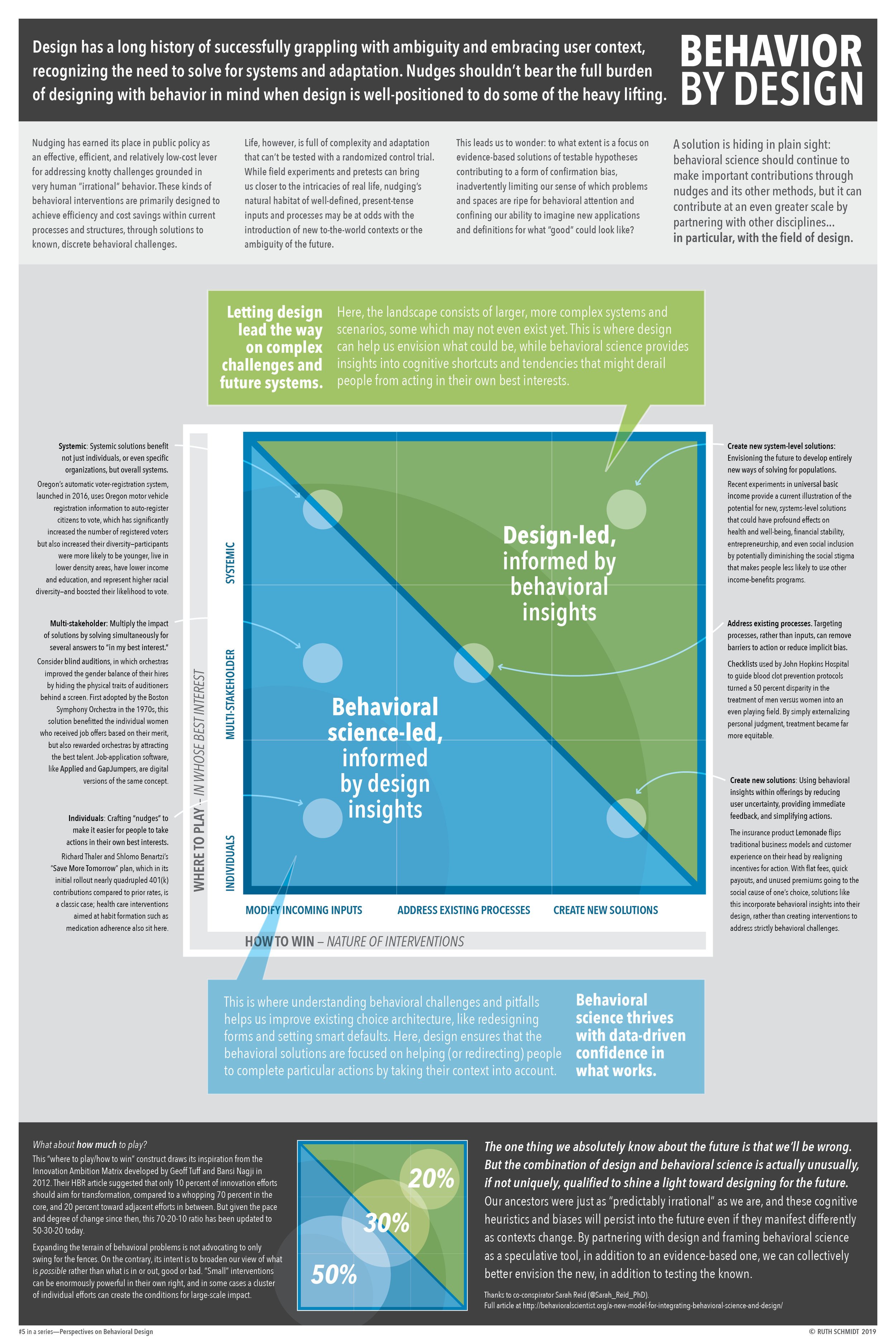A New Model for Integrating Behavioral Science and Design
To what extent are we inadvertently limiting the range of problems for behavioral science’s attention?
This article is part of Behavioral Scientist’s special issue “Nudge Turns 10,” which explores the intersection of behavioral science and public policy.
Published by Behavioral Scientist
By Sarah Reid and Ruth Schmidt
September 17, 2018
Nudging has rightfully earned its place in public policy as an effective, efficient, and relatively low-cost lever for addressing knotty challenges grounded in very human “irrational” behavior: Which message encourages citizens to get out the vote or pay their taxes on time? What mix of social norms, commitment devices, and prompts increases medication adherence? These kinds of behavioral interventions are primarily designed to achieve efficiency and cost savings within current processes and structures, through solutions to known, discrete behavioral challenges. Think of it as process improvement, nudge-style.
Life, however, is full of complexity and adaptation that can’t be tested with a randomized control trial. While field experiments and pretests can bring us closer to the intricacies of real life, nudging’s natural habitat of well-defined, present-tense inputs and processes may be at odds with the introduction of new to-the-world contexts or the ambiguity of the future. Nudges, and behavioral science more generally, can absolutely help people save more for tomorrow, today. But tomorrow may be characterized by a completely different set of life-stage or employment norms and conditions that upend our current conceptions of retirement above and beyond the mechanics of saving into 401(k) accounts.
This leads us to wonder: to what extent is a focus on evidence-based solutions of testable hypotheses contributing to a form of confirmation bias, inadvertently limiting our sense of which problems and spaces are ripe for behavioral attention and confining our ability to imagine new applications and definitions for what “good” could look like? Thaler and Sunstein knew that nudges were a piece of the behavioral change puzzle but not the only piece. So what’s missing?
Part of the solution, we suspect, is hiding in plain sight: behavioral science can and should continue to make important contributions through nudges and its other methods, but we believe it can contribute at an even greater scale by turning outward to partner with other disciplines—in particular, with the field of design.
Behavioral science can contribute at an even greater scale by turning outward to partner with other disciplines—in particular, with the field of design.
Design is a strategic lens with a history of grappling with ambiguity and embracing user context, recognizing the need to solve at the level of systems while also keeping one eye on the future by building solutions that are designed to adapt. To do this, design uses a combination of generative, participatory, and evaluative modes to expand our notions of what we should even be solving for, as well as how to solve for it—with outcomes that are viable and sustainable, desirable for all stakeholders, and technologically feasible to build. Organizations as diverse as the Mayo Clinic, Proctor & Gamble, IBM, and the United States government have successfully integrated a design mindset into how they conceive of, build, and deliver services, experiences, or even new businesses.
There’s already increasing buzz about how applying “design thinking” can add value to behavioral interventions, but the value of applying behavioral insights to design problems is equally clear. Struggles with uncertainty, helping users achieve what they value, confirmation bias, time discounting—all of these concepts are inextricably embedded in the challenges that design sets out to solve. By coming in fully armed with a knowledge of behavioral tendencies and levers, we can vastly improve our chances of designing more robust and effective solutions.
Consider the model below. In this conception, the bottom left corner is where behavioral science thrives and design supports. This is where understanding behavioral challenges and pitfalls helps us improve existing choice architecture, like redesigning forms and setting smart defaults. Here, design ensures that the behavioral solutions are focused on helping (or redirecting) people to complete particular actions by taking their context into account.
The top right corner is where design takes the lead and behavioral science plays a supporting role. Here, the landscape consists of larger, more complex systems and scenarios, some which may not even exist yet. This is where design can help us envision what could be, while behavioral science provides insights into cognitive shortcuts and tendencies that might derail people from acting in their own best interests. Solutions in this space might take shape as a new welfare system like universal basic income or a new way to choose, negotiate, and manage health insurance.
This new model draws its inspiration from Bansi Nagji and Geoff Tuff’s Innovation Ambition Matrix, introduced in 2012 as a means to guide organizational investment in innovation. The matrix was itself a riff on a framework by management theorist H. Igor Ansoff, and consisted of a simple 3×3 matrix defined by two axes: “Where to play,” defined as a continuum of playing in existing markets with existing customers on one end, to creating entirely new ones at the other; and “How to win,” which ranged from existing products up to entirely new offerings.
Innovation Ambition Matrix, Nagji and Tuff, Harvard Business Review
This visual representation and line of thinking helped companies reframe innovation in two important ways.
First, it provided a new language to describe the nature of innovative solutions as core (optimizing current processes and offerings), adjacent (reaching adjacent customers, developing incrementally new offerings), and transformational (achieving market disruption), according to their position within the matrix. This was not only descriptively useful but also provided a shared set of definitions to help people talk about innovation with greater consistency.
Second, the model also introduced a way to reconceptualize innovation as a landscape, in which one could gauge how individual innovation initiatives within a company sat relative to one another—in other words, taking a portfolio, or systems, view. This allowed organizations to clarify their innovation goals more holistically and helped them better plan and measure the collective success of innovations.
The frame of “where to play” and “how to win” provided businesses with new ways of describing and thinking about of innovation, thinking that allowed them to be both more precise and more strategic. Transplanted into a behavioral context, the structure has the potential to help us imagine a broader landscape of challenges to address, and it arms us with a new syntax to coordinate our efforts.
Where to Play: Individuals -> Multi-stakeholders -> Systemic
The original “where to play” axis focused on the “stretchiness” of potential audiences and markets in the context of gaining a competitive advantage. In our reimagined behavioral version, we translated this strategic focus on audience as “in whose best interest” the behavioral interventions are designed for—individuals, multiple stakeholders, and entire systems.
Individuals. Examples where nudges focus on an individual’s best interest abound. Richard Thaler and Shlomo Benartzi’s “Save More Tomorrow” plan, which in its initial rollout nearly quadrupled 401(k) contributions compared to prior rates, is a classic case; health care interventions aimed at habit formation such as medication adherence also sit here.
Multi-stakeholder. These interventions multiply the impact of solutions by solving simultaneously for several answers to “in my best interest.” As an example, consider blind auditions, in which orchestras improved the gender balance of their hires by hiding the physical traits of auditioners behind a screen. First adopted by the Boston Symphony Orchestra in the 1970s, this solution benefitted the individual women who received job offers based on their merit, but also rewarded orchestras by attracting the best talent. Job-application software, like Applied and GapJumpers, are digital versions of the same concept. They blind cues like names, gender, and ethnicities from evaluators, and emphasize candidate aptitude and task-oriented competencies that more tangibly link to prospective performance and merit. Other efforts in this space include simplifying labels, using social-comparison framing to reduce energy consumption and increase recycling behavior, and using short-term incentives in government-backed energy efficiency programs to boost greener consumption habits.
Systemic. Systemic solutions benefit not just individuals, or even specific organizations, but overall systems. The well-known opt-out and prompted-choice approaches for organ donation are two such examples, in which recognizing the power of default options has been shown to be highly effective in increasing both the base of potential donors and the likelihood of their organs being used, to the benefit of the entire system.
Voting is another arena in which behavioral insights have had a significant systems-level impact. Oregon’s automatic voter-registration system, launched in 2016, uses Oregon motor vehicle registration information to auto-register citizens to vote. This system has not only significantly increased the number of registered voters but also increased their diversity—participants were more likely to be younger, live in lower density areas, have lower income and education, and represent higher racial diversity—and boosted their likelihood to vote. Other recent “get out the vote” campaigns using behavioral prompts such as social nudges and precommitments have been shown to help people, especially those who live alone, establish a plan for how to get to polling stations. Solutions like these have not only stretched the impact of organizational budgets but also arguably improved systemic representativeness in the democratic process.
How to Win: Shift incoming inputs -> Shift existing processes -> Create new solutions
“How to win” is grounded in the newness of the offerings provided by an organization; in our version, we’ve substituted in the nature and scale of behavioral interventions—from adjusting current inputs and processes up to developing entirely new solutions.
Shift incoming inputs. The examples provided above are primarily instances of shifting incoming inputs, in which interventions are aimed at influencing the range or definition of what currently exists. This approach focuses on countering the biases that may limit our perceptions of viable options or, in default and opt-out situations, reducing or even eliminating the need to choose at all.
Shift existing processes. Sometimes, targeting processes, rather than inputs, is a more effective way to remove barriers to action or reduce implicit bias. A simple, yet highly effective, example is the checklist. Checklists used by John Hopkins Hospital to guide blood clot prevention protocols turned a 50 percent disparity in the treatment of men versus women into an even playing field. By simply externalizing personal judgment, treatment became far more equitable.
Streamlining processes to remove even small points of friction has also proven fruitful, especially with low frequency, low motivation tasks like filing taxes. The Behavioural Insights Team nudged better tax filing behavior by sending a form directly to participants rather than sending them to a website to download the form. Removing this one click increased use of the form from 19 percent to 23 percent, at virtually no cost.
Create new solutions. The insurance product Lemonade flips traditional business models and customer experience on their head by realigning incentives for action. With flat fees, quick payouts, and unused premiums going to the social cause of one’s choice, solutions like this suggest an exciting direction for products and services that incorporate behavioral insights into their design, rather than creating interventions to address strictly behavioral challenges. Other familiar examples include Uber or Amazon Prime’s One-Click. These leverage behavioral insights within broader offerings, by reducing user uncertainty, providing immediate feedback, and simplifying actions to make their services almost too easy to not use.
In a public-policy vein, recent experiments in universal basic income provide a current illustration of the potential for new, systems-level solutions that could have profound effects on health and well-being, financial stability, entrepreneurship, and even social inclusion; as Johnny Hugill and Matija Franklin note, embracing a universal basic income could diminish the social stigma that makes people less likely to use other income-benefits programs.
Putting the Model to Use
Expanding the terrain of behavioral problems to solve is not the same as advocating to only swing for the fences. On the contrary, its intent is to broaden our view of what is possible rather than declaring what is in or out, good or bad. So-called “small” interventions can be enormously powerful in their own right, and in some cases a cluster of individual efforts can create the conditions for large-scale impact and long-term change.
In fact, the original article suggested that only 10 percent of innovation efforts should aim for transformation, compared to a whopping 70 percent in the core, and 20 percent toward adjacent efforts in between. Nudges that focus on inputs and target individual behaviors, like process improvement efforts, are and will continue to be critically important tools in public policy. Our argument is that in the same way that many individual adjustments to the hotel experience would never have yielded Airbnb, expanding room for behavioral design to inform new policy may yield other benefits, and a focus on aggregated small wins may be insufficient if it is the only model we rely on.
By partnering with design and framing behavioral science as a speculative tool, in addition to an evidence-based one, we can collectively better envision the new, in addition to testing the known.
A new book bolsters the case for stretching beyond “core” behavioral interventions. His updated model parallels the structure of our proposed bottom-left and top-right triangles, labeling them “known/knowable opportunities” and “unknown/unknowable opportunities,” respectively. The former is the terrain of identified challenges, which can be addressed with known insights and tools. This is largely where behavioral science has played so far. The latter, by contrast, requires new approaches to identify those challenges, let alone solve for them and gauge the success of solutions—exactly the conditions that play to the strengths of design.
It’s also worth noting that the 70-20-10 ratio offered in the 2012 version has been updated to 50-30-20 today, with the recommendation of using 50 percent of innovation budgets for core improvements, 30 percent toward adjacent areas, and 20 percent toward transformation. While the worlds of innovation and behavioral design are not precisely equivalent, we can’t help but agree that it’s valuable to look beyond traditional problem-solving boundaries when it comes to behavior.
Framing the power of behavioral insights within a design-led perspective amplifies our ability to navigate complexity and uncertainty and create effective and adaptive public policy at scale with the future, as well as the present, in mind. Of course, the one thing we absolutely know about the future is that we’ll be wrong. But despite a bias toward testable, empirical hypotheses that deliver present-tense proof of efficacy, behavioral science is actually unusually, if not uniquely, qualified to shine a light on designing for the future. Our ancestors were just as “predictably irrational” as we are, and cognitive heuristics and biases will persist into the future even if they manifest differently as contexts change. By partnering with design and framing behavioral science as a speculative tool, in addition to an evidence-based one, we can collectively better envision the new, in addition to testing the known.
Original article at Behavioral Scientist


